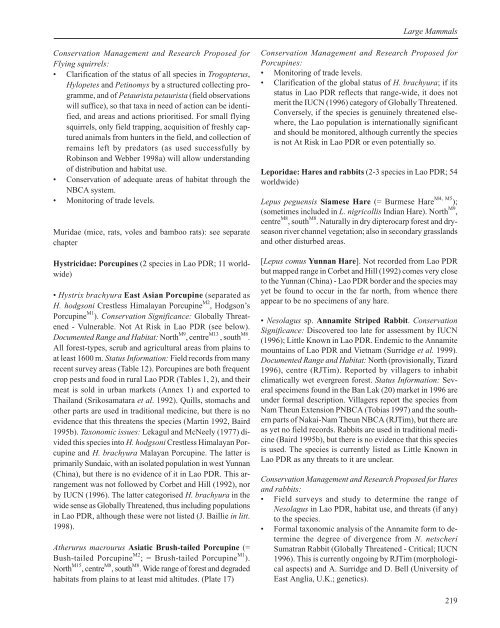Wildlife of Lao PDR: 1999 Status Report - IUCN
Wildlife of Lao PDR: 1999 Status Report - IUCN
Wildlife of Lao PDR: 1999 Status Report - IUCN
Create successful ePaper yourself
Turn your PDF publications into a flip-book with our unique Google optimized e-Paper software.
Conservation Management and Research Proposed for<br />
Flying squirrels:<br />
• Clarification <strong>of</strong> the status <strong>of</strong> all species in Trogopterus,<br />
Hylopetes and Petinomys by a structured collecting programme,<br />
and <strong>of</strong> Petaurista petaurista (field observations<br />
will suffice), so that taxa in need <strong>of</strong> action can be identified,<br />
and areas and actions prioritised. For small flying<br />
squirrels, only field trapping, acquisition <strong>of</strong> freshly captured<br />
animals from hunters in the field, and collection <strong>of</strong><br />
remains left by predators (as used successfully by<br />
Robinson and Webber 1998a) will allow understanding<br />
<strong>of</strong> distribution and habitat use.<br />
• Conservation <strong>of</strong> adequate areas <strong>of</strong> habitat through the<br />
NBCA system.<br />
• Monitoring <strong>of</strong> trade levels.<br />
Muridae (mice, rats, voles and bamboo rats): see separate<br />
chapter<br />
Hystricidae: Porcupines (2 species in <strong>Lao</strong> <strong>PDR</strong>; 11 worldwide)<br />
• Hystrix brachyura East Asian Porcupine (separated as<br />
H. hodgsoni Crestless Himalayan Porcupine M2 , Hodgson’s<br />
Porcupine M1 ). Conservation Significance: Globally Threatened<br />
- Vulnerable. Not At Risk in <strong>Lao</strong> <strong>PDR</strong> (see below).<br />
Documented Range and Habitat: North M9 , centre M13 , south M8 .<br />
All forest-types, scrub and agricultural areas from plains to<br />
at least 1600 m. <strong>Status</strong> Information: Field records from many<br />
recent survey areas (Table 12). Porcupines are both frequent<br />
crop pests and food in rural <strong>Lao</strong> <strong>PDR</strong> (Tables 1, 2), and their<br />
meat is sold in urban markets (Annex 1) and exported to<br />
Thailand (Srikosamatara et al. 1992). Quills, stomachs and<br />
other parts are used in traditional medicine, but there is no<br />
evidence that this threatens the species (Martin 1992, Baird<br />
1995b). Taxonomic issues: Lekagul and McNeely (1977) divided<br />
this species into H. hodgsoni Crestless Himalayan Porcupine<br />
and H. brachyura Malayan Porcupine. The latter is<br />
primarily Sundaic, with an isolated population in west Yunnan<br />
(China), but there is no evidence <strong>of</strong> it in <strong>Lao</strong> <strong>PDR</strong>. This arrangement<br />
was not followed by Corbet and Hill (1992), nor<br />
by <strong>IUCN</strong> (1996). The latter categorised H. brachyura in the<br />
wide sense as Globally Threatened, thus including populations<br />
in <strong>Lao</strong> <strong>PDR</strong>, although these were not listed (J. Baillie in litt.<br />
1998).<br />
Atherurus macrourus Asiatic Brush-tailed Porcupine (=<br />
Bush-tailed Porcupine M2 ; = Brush-tailed Porcupine M1 ).<br />
North M15 , centre M8 , south M8 . Wide range <strong>of</strong> forest and degraded<br />
habitats from plains to at least mid altitudes. (Plate 17)<br />
Large Mammals<br />
Conservation Management and Research Proposed for<br />
Porcupines:<br />
• Monitoring <strong>of</strong> trade levels.<br />
• Clarification <strong>of</strong> the global status <strong>of</strong> H. brachyura; if its<br />
status in <strong>Lao</strong> <strong>PDR</strong> reflects that range-wide, it does not<br />
merit the <strong>IUCN</strong> (1996) category <strong>of</strong> Globally Threatened.<br />
Conversely, if the species is genuinely threatened elsewhere,<br />
the <strong>Lao</strong> population is internationally significant<br />
and should be monitored, although currently the species<br />
is not At Risk in <strong>Lao</strong> <strong>PDR</strong> or even potentially so.<br />
Leporidae: Hares and rabbits (2-3 species in <strong>Lao</strong> <strong>PDR</strong>; 54<br />
worldwide)<br />
Lepus peguensis Siamese Hare (= Burmese Hare M4, M5 );<br />
(sometimes included in L. nigricollis Indian Hare). North M9 ,<br />
centre M8 , south M8 . Naturally in dry dipterocarp forest and dryseason<br />
river channel vegetation; also in secondary grasslands<br />
and other disturbed areas.<br />
[Lepus comus Yunnan Hare]. Not recorded from <strong>Lao</strong> <strong>PDR</strong><br />
but mapped range in Corbet and Hill (1992) comes very close<br />
to the Yunnan (China) - <strong>Lao</strong> <strong>PDR</strong> border and the species may<br />
yet be found to occur in the far north, from whence there<br />
appear to be no specimens <strong>of</strong> any hare.<br />
• Nesolagus sp. Annamite Striped Rabbit. Conservation<br />
Significance: Discovered too late for assessment by <strong>IUCN</strong><br />
(1996); Little Known in <strong>Lao</strong> <strong>PDR</strong>. Endemic to the Annamite<br />
mountains <strong>of</strong> <strong>Lao</strong> <strong>PDR</strong> and Vietnam (Surridge et al. <strong>1999</strong>).<br />
Documented Range and Habitat: North (provisionally, Tizard<br />
1996), centre (RJTim). <strong>Report</strong>ed by villagers to inhabit<br />
climatically wet evergreen forest. <strong>Status</strong> Information: Several<br />
specimens found in the Ban Lak (20) market in 1996 are<br />
under formal description. Villagers report the species from<br />
Nam Theun Extension PNBCA (Tobias 1997) and the southern<br />
parts <strong>of</strong> Nakai-Nam Theun NBCA (RJTim), but there are<br />
as yet no field records. Rabbits are used in traditional medicine<br />
(Baird 1995b), but there is no evidence that this species<br />
is used. The species is currently listed as Little Known in<br />
<strong>Lao</strong> <strong>PDR</strong> as any threats to it are unclear.<br />
Conservation Management and Research Proposed for Hares<br />
and rabbits:<br />
• Field surveys and study to determine the range <strong>of</strong><br />
Nesolagus in <strong>Lao</strong> <strong>PDR</strong>, habitat use, and threats (if any)<br />
to the species.<br />
• Formal taxonomic analysis <strong>of</strong> the Annamite form to determine<br />
the degree <strong>of</strong> divergence from N. netscheri<br />
Sumatran Rabbit (Globally Threatened - Critical; <strong>IUCN</strong><br />
1996). This is currently ongoing by RJTim (morphological<br />
aspects) and A. Surridge and D. Bell (University <strong>of</strong><br />
East Anglia, U.K.; genetics).<br />
219

















